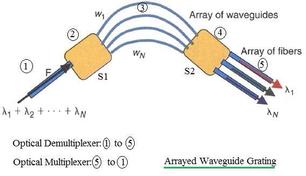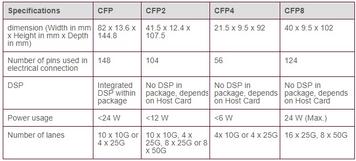
10 Applications of Photodiodes: Working, Types, Advantages, and Limitations
Explore the function, types and 10 applications of photodiodes, from fiber optics to medical devices, and their advantages and limitations.
Showing 25 posts (Page 1 of 2)
Advertisement

Explore the function, types and 10 applications of photodiodes, from fiber optics to medical devices, and their advantages and limitations.
Prepare for your fiber optic engineer interview with these 10 key questions and answers covering optical communication principles and technologies.

Explore the fundamentals of Arrayed Waveguide Gratings (AWGs) in optical fiber communication, their operation as optical MUX/DEMUX devices, characteristics, and applications in DWDM and FTTx networks.

Learn about CFP (C Form Factor Pluggable), its specifications, and different types like CFP, CFP2, CFP4, and CFP8 used in high-speed networking.
Explore the functionality, applications, and advantages of diode-pumped lasers (DPLs), highlighting their efficiency, compactness, and versatility in various industries.
Terabit Ethernet (TbE) emerges as the next frontier in Ethernet technology, promising unprecedented data transfer speeds to meet the rising demands of data-intensive applications.

Explore the differences between Fabry-Perot (FP) and Distributed Feedback (DFB) lasers, including their applications, cost, output power, and spectral width.

Calculate the fiber loss margin using this online calculator. Learn about the formula and its components for optical fiber communication.

Explore the benefits and drawbacks of Free Space Optics (FSO) technology, including license-free operation, atmospheric losses, and security concerns.

Explore the differences, advantages, and disadvantages of internal and external light modulation techniques used in optical applications.

Explore the pros and cons of laser technology, from high-speed communication to medical treatments, considering its impact, safety, and costs.

Learn the basics of LiFi technology, a wireless communication method using light to transmit data. Discover its features, how it works, and its advantages over WiFi.

Explore the LiFi dongle and transceiver: its block diagram, working principles, and role in delivering internet over light waves for LiFi-based systems.

Explore the fundamentals of the LiFi MAC layer, including frame structure, single, packed, burst and dimmed OOK modes. Understand how LiFi efficiently transmits data.

Explore the LiFi physical layer (PHY), including PHY-I, PHY-II, and PHY-III versions, their features, modulation, and code rates for different data rate needs.

Explore LiFi technology: its protocol layers, how it works, and its applications. Learn about this high-speed, secure wireless communication method using visible light.
Explore the key differences between multi-core and single-core fiber optic cables, including advantages, disadvantages, and applications in optical communications.
Learn about Optical Polarization Shift Keying (PolSK) modulation, its variants like MPolSK, BPolSK, and DCPolSK, and its role in optical communication systems.

Explore the fundamentals of optical switching, including space, wavelength, time, and hybrid switching techniques. Learn about core components and applications.

Explore the key differences between optical and wireless communication technologies, including data capacity, deployment, relocation ease, and environmental effects.
Explore optoamplifiers: EDFA, SOA, and Raman amplifiers. Understand their specifications, gain, bandwidth, and applications in optical communication systems.

Explore the function of optocirculators in optical communication, including bidirectional links, specifications, and applications like WDM and OTDRs.

Explore the differences between QPSK and DP-QPSK modulation techniques, their applications, and advantages of DP-QPSK in optical communication.

Explore various types of repeaters used in communication systems like WiFi, LTE, satellite, and optical, highlighting their functionalities and differences from amplifiers.

Explore the differences between RZ, NRZ, CRZ, and CSRZ line encoding schemes, including signal characteristics, advantages, disadvantages, and applications in digital communication.
Advertisement